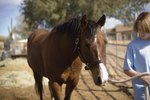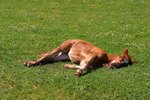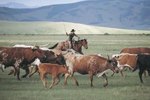
When getting your own horse, you may wonder if he is best kept in a pasture or stall. While there are advantages and disadvantages with each situation, most experts suggest utilizing both indoor and outdoor living to give the horse the benefits of both. After considering the following information, determine what will work best for both you and your horse.
Stall Advantages
Though horses grow a water-resistant coat in cooler weather, a stall or barn provides additional protection from the elements year-round. The roof and walls give shade in the hot summer and act a barrier from snow, wind and rain. Well-ventilated stables and clean stalls help prevent inflammatory airway disease, or heaves. Stalls also allow you to feed multiple horses individually to monitor their food intake. Finally, you won't have to chase your horse around a large area to tack him up.
Stall Disadvantages
Imagine being kept in an office cubicle all day and you might have an idea of how a horse feels when cooped up in a stall. Horses are social creatures, benefiting from interaction with others. Confinement can lead to many behavioral issues exhibited by wood chewing, pawing the stall sides and constant pacing from boredom. In some cases, the horse shows aggression and is less amicable when handled. If this happens, introduction to a companion animal, such as a goat or donkey, may calm him down. Even still, a horse needs to be taken out for exercise and have his stall cleaned daily.
Pasture Advantages
Simply put, it is a horse's most natural state to be outside and in the company of other horses. Here he can graze on grass for several hours a day as a healthy, natural supplement to his diet. Horse companions exercise by playing together, creating both a happy horse and a strong social unit. Furthermore, as prey animals the group relies on their numbers to feel safe and secure.
Pasture Disadvantages
When in the pasture all day, a horse is exposed to parasites or biting bugs, like the mosquito. Putting a fly mask on your horse keeps the bugs out of his eyes, but he can still be bitten. The horse is also exposed to the harsh weather elements. Some pastures are equipped with run-ins, a small, basic shelter with a large entrance that sometimes replaces an indoor stall. However, certain breeds, like the Arabian, cannot tolerate the cold and are unsuited for living entirely outdoors. Horses companions can develop a codependency, refusing to be separated. On the other hand, an alpha horse can eat too much, denying food to the "underdog" of the group. Injuries can occur when horses kick each other, whether intentional or not, though keeping the hind legs shoeless prevents a more serious injury. Pastures are like stalls, only much larger, and must still be cleaned with the perimeter fence maintained to prevent escape or injury. Toxic plants and weeds must be removed.
Combining Stall and Pasture
Under ideal circumstances, your horse will be housed in a barn stall and put out to pasture during the day in winter or in the cool evenings throughout the summer. For those without a pasture, take your horse out regularly for exercise, with a companion horse if possible. Pasture-only horses should still have a suitable run-in, kept clean and dry, with plenty of trees dotted throughout the land for shade. Both circumstances require your daily attention and care. Stalls need to be mucked out regularly, and horses kept outside require additional grooming from any extra dirt and mud picked up.
References
Photo Credits
-
Comstock Images/Comstock/Getty Images
Writer Bio
Pam Smith has been writing since 2005. In addition to her work for Demand Media, her articles have been published online at CBS Local. She also wrote for the Pennsylvania Center for the Book's Literary Map while earning a Bachelor of Arts degree in English at the Pennsylvania State University. She is currently an editorial assistant for Circulation Research.




